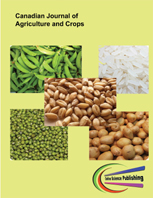Allelopathic Potential of Sorghum Residues in Control of Two Weeds, the Great-Brome and Milk-Thistle
DOI:
https://doi.org/10.55284/cjac.v7i1.602Keywords:
Allelopathy, Milk-thistle, Great-brome, Sorghum, Weed control.Abstract
Biological weed control through the use of the ‘natural herbicide’ potential of certain allelopathic crops could be an alternative to conventional herbicidal methods. This work was carried out to investigate the allelopathic potential of a ‘Super Graze II’ hybrid of forage sorghum (Sorghum bicolor L.), used as a cover crop by growers who practice conservation agriculture in Tunisia, to control two endemic weeds, the great-brome (Bromus diandrus) and milk-thistle (Silybum marianum), that infest the fields where winter straw cereals are grown in the semi-arid zone of Tunisia, causing yield losses. A bioassay was used to evaluate the phytotoxicity of sorghum plant components and root exudates. Water extracts of the sorghum expressed an inhibitory effect on the germination and seedlings’ growth of the weeds. Radicle growth was more affected than coleoptiles growth. Stem-extract was the most phytotoxic on radicle growth of great-brome and milk-thistle with inhibition of 66% and 86%, respectively. Regardless of the weed species, the effect of root exudates of sorghum was significant (p=0.05). Radicle length was more affected than coleoptiles length which was reduced by 42% and 71%, for great-brome and milk-thistle, respectively. Sorghum was more efficient for milk-thistle control. The results showed a potential use of sorghum as a natural herbicide, either alone or in combination with classical control methods. This practice should consider the choice of a cereal species/variety in succession tolerant to the phytotoxicity expressed by the sorghum hybrid.


